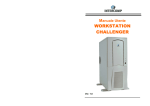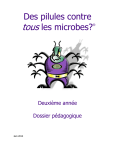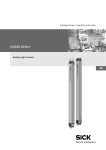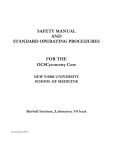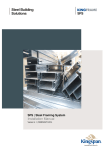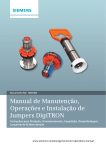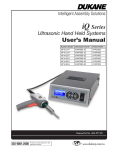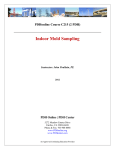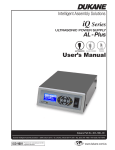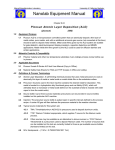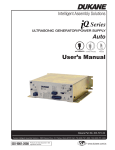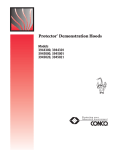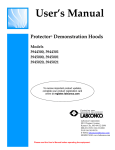Download - Bio-Rad
Transcript
S3™ Biosafety System Class I Instruction Manual Catalog #145-1078 #145-1021 #145-1022 #145-1029 #145-1030 Bio-Rad Technical Support For help and technical advice, please contact the Bio-Rad Technical Support department. In the United States, the Technical Support department is open Monday–Friday, 5:00 AM–5:00 PM, Pacific time. http://www.bio-rad.com Bio-Rad Laboratories Life Science Research 2000 Alfred Nobel Drive Hercules, CA 94547 Telephone: 510-741-1000 Telex: 335-358 Toll Free: 1-800-4-BIORAD (1-800-424-6723) Fax: 510-741-5800 Free Fax: 1-800-879-2289 Online technical support and worldwide contact information are available at www.consult.bio-rad.com. Legal Notices HEPA is a trademark of HEPA Corporation. Glo Germ is a trademark of Glo Germ Company. Instapak is a trademark of Sealed Air Corporation. No part of this publication may be reproduced or transmitted in any form or by any means, electronic or mechanical, including photocopy, recording, or any information storage or retrieval system, without permission in writing from Bio-Rad Laboratories. Bio-Rad reserves the right to modify its products and services at any time. This instruction manual is subject to change without notice. Although prepared to ensure accuracy, Bio-Rad assumes no liability for errors, or for any damages resulting from the application or use of this information. Copyright © 2014 by Bio-Rad Laboratories, Inc. All rights reserved. Instruction Manual | i Bio-Rad Laboratories Resources Bio-Rad provides many resources for scientists. Table 1 lists available resources and how to locate what you need. Table 1. Bio-Rad resources. Resource How to Contact Local Bio-Rad Laboratories Find local information and contacts on the Bio-Rad Laboratories website by selecting your country representativeson the homepage (www.bio-rad.com). Find the nearest international office listed on the back of this manual Technical support scientistsBio-Rad’s technical support scientists provide our customer with practical and expert solutions. To find local technical support on the phone, contact your nearest Bio-Rad office. For technical support in the United States and Canada, call 1-800-424-6723 (toll-free), and select the technical support option Service support engineers Maintenance and repairs should be carried out only by authorized service support engineers For service support in the United States and Canada, call 1-800-424-6723 (toll-free), and select the technical support option to request service support Technical notes and literatureGo to the Bio-Rad website (www.bio-rad.com). Type a term in the Search box and select Documents tab to find links to literature Writing Conventions Used in This Manual This manual uses the writing conventions listed in Table 2. Table 2. Conventions used in this manual. Convention Meaning Note: Provides helpful information and instructions, including information explained in further detail elsewhere in this manual WARNING!Explains very important information about something that might injure the researcher, damage the instrument, or cause data loss X > Y Instruction to select X and then select Y from a toolbar, menu, or software window Highlights area of interest on a screenshot IMPORTANT! Provides important information about necessary actions or common mistakes ii | S3 Biosafety System Safety and Regulatory Compliance For safe operation of the S3 biosafety system with use of the S3 or S3e cell sorter, we strongly recommend that you follow the safety specifications listed in this section and throughout the manual. Safety Warning Labels Warning labels posted on the instrument and in this manual warn you about sources of injury or harm. Refer to Table 3 to review the meaning of each safety warning label. Table 3. Meaning of safety warning labels. AUTION: Shock hazard! This symbol draws attention to a possible injury or danger to life if the associated C directions are not followed correctly CAUTION: Risk of danger! This symbol identifies components that pose a risk of personal injury or damage to the instrument if improperly handled. Wherever this symbol appears, consult the manual for further information before proceeding CAUTION: Biohazard! This symbol identifies components that may become contaminated with biohazardous material Instrument Warning Labels The warning labels shown in Table 4 are displayed on the instrument and refer directly to the safe use of the S3 or S3e cell sorter when in use with the S3 biosafety system. Table 4. Instrument safety warning labels. Warning about electronic components. Electronic components are sensitive to electrostatic charges and can be destroyed by a discharge Warning about weight of the system. Lifting should be accomplished with a minimum of two people and only by the inset handles on the instrument base. Use caution to keep instrument level and handle gently Warning about handling biohazardous materials. When handling biohazardous samples or the S3 systems waste container, adhere to the recommended precautions and guidelines in this manual, and comply with any local guidelines specific to your laboratory and location arning about risk of shock. W Only qualified, trained technicians should carry out service work on electronic components due to potential shock hazard Instruction Manual | iii Safe Use Specifications and Compliance Electrical Safety Information and Classification The S3 biosafety system conforms to international regulations encompassing the accessibility of high voltages by the user. Use all protective housings, interlocks, and shields as identified in this manual. Further information about specific electrical hazards is listed in the hardware description. AC Fuse Requirements Remove power cord before replacing fuses. Fuses are 5 x 20 mm and must be rated to 250 VAC, 2.0 A slow blow. AC Power Cord Requirements Power cord must be IEC 60320-1 compliant with a C13 plug on the instrument end. The power cord must be rated at minimum 250 VAC, 10 A at 60ºC minimum. In the U.S. and Canada, the power cord must be rated at minimum 125 VAC, 10 A at 60ºC minimum. Position the instrument for easy access to the power switch and the power cord. The plug and power cord must remain dry. Always use a grounded outlet for powering the unit. Regulatory Compliance This equipment generates, uses, and can radiate radio frequency energy and, if not installed and used in accordance with the instruction manual, may cause harmful interference to radio communications. Operation of this equipment in a residential area is likely to cause harmful interference, in which case the user will be required to correct the interference at his/her own expense. This instrument has been tested and found to be in compliance with all applicable requirements of the following safety and electromagnetic standards: n n n IEC 61010-1:2010 (3rd Ed.), EN61010-1:2010 (3rd Ed). Electrical Equipment for Measurement, Control, and Laboratory Use - Part 1: General Requirements UL/CSA 61010-1:2012 (3rd Ed.), Standard for Safety Electrical Equipment for Electrical Safety (USA, Canada, NRTL) EN 61326-1:2006 (Class A). Electrical equipment for measurement, control and laboratory use. EMC requirements - Part 1: General requirements The S3 or S3e cell sorter operated inside the S3 biosafety system has been tested and found to be in compliance with all applicable requirements for Class 1 laser safety per CDRH and electromagnetic standards. Please refer to the S3 and S3e Cell Sorter manual for more information. Hazards The S3 biosafety system is designed to operate safely when used in the manner prescribed by the manufacturer. If the S3 biosafety system or any of its associated components are used in a manner other than prescribed, or if modifications to the instrument are not performed by a Bio-Rad or other authorized agent, then the warranty on the system will be voided. Service of the S3 biosafety system should be performed only by authorized Bio-Rad personnel or a certified biosafety service vendor. Biohazards The S3 biosafety system is a laboratory product. However, if biohazardous samples are present or used with the S3 or S3e cell sorter, adhere to the following guidelines and comply with any local guidelines specific to your laboratory and location. General Precautions Personal protective equipment (PPE) must be used when working with biological samples. Refer to your institution’s Environmental Health & Safety guidelines for samples at different biosafety levels. Disposal of Biohazardous Material The S3 or S3e cell sorter inside the S3 biosafety system includes a waste container that may potentially contain hazardous biological materials, depending on the sample used. Dispose of the following potentially contaminated materials in accordance with laboratory, local, regional, and national regulations: n Content in waste container n Reagents n Used reaction vessels or other consumables that may be contaminated iv | S3 Biosafety System Chemical Hazards The S3 or S3e cell sorter inside the S3 biosafety system includes a waste container that may potentially contain hazardous chemical materials depending on the sample used. Explosive or Flammability Hazards The S3 biosafety system poses no uncommon hazard related to flammability or explosion when used in a proper manner as specified by Bio-Rad Laboratories. Electrical Hazards The S3 biosafety system poses no uncommon electrical hazard to operators if installed and operated properly without physical modification and if connected to a power source of proper specification. Transport Moving the S3 biosafety system and the cell sorter is not recommended after installation. If the complete system needs to be moved, follow the decontamination procedure in both this manual and the S3 and S3e cell sorter manual and remove all bulk fluidics prior to moving. If the system must be moved, the S3 biosafety system should be disassembled prior to moving the S3 or S3e cell sorter off the HDPE base floor. Lifting should be performed with a minimum of two people. After moving the S3 or S3e cell sorter and the biosafety system and upon reassembly, the system must be recertified by a certified biosafety service vendor. Storage The S3 and S3e systems can be stored under the following conditions: n Temperature range: 18–25°C n Relative humidity: 20–60% Disposal The S3 biosafety system contains electronic or electrical materials; it should be disposed of as unsorted waste and must be collected separately, according to European Union Directive 2002/96/CE on waste and electronic equipment — WEEE Directive. Before disposal, contact your local Bio-Rad representative for country-specific instructions. Warranty The S3 and S3e cell sorters and associated accessories are covered by a standard Bio-Rad warranty. Contact your local Bio-Rad Laboratories office for details of the warranty. IMPORTANT! Use equipment only for intended purpose. Improper use voids the warranty and may result in injury. Instruction Manual | v vi | S3 Biosafety System Table of Contents Chapter 1 Introduction . . . . . . . . . . . . . . . . . . . . . . . . . . . . . . . . . . . . . . . . . . . . 1 System Components . . . . . . . . . . . . . . . . . . . . . . . . . . . . . . . . . . . . . . . . . . . . . . . . . . . . . . 2 Hardware Overview . . . . . . . . . . . . . . . . . . . . . . . . . . . . . . . . . . . . . . . . . . . . . . . . . . . . . . . 3 Specifications . . . . . . . . . . . . . . . . . . . . . . . . . . . . . . . . . . . . . . . . . . . . . . . . . . . . . . . . . . . . 4 Chapter 2 Operation . . . . . . . . . . . . . . . . . . . . . . . . . . . . . . . . . . . . . . . . . . . . . . 5 Airflow Management . . . . . . . . . . . . . . . . . . . . . . . . . . . . . . . . . . . . . . . . . . . . . . . . . . . . . . 5 Software Control . . . . . . . . . . . . . . . . . . . . . . . . . . . . . . . . . . . . . . . . . . . . . . . . . . . . . . . . . 6 Working with the S3 and S3e Cell Sorters . . . . . . . . . . . . . . . . . . . . . . . . . . . . . . . . . . . . . . 8 Using the Access Doors . . . . . . . . . . . . . . . . . . . . . . . . . . . . . . . . . . . . . . . . . . . . . . . . . 8 Vinyl Side Panel Operation . . . . . . . . . . . . . . . . . . . . . . . . . . . . . . . . . . . . . . . . . . . . . . 10 Chapter 3 Maintenance . . . . . . . . . . . . . . . . . . . . . . . . . . . . . . . . . . . . . . . . . . . 11 Cleaning and Sterilization . . . . . . . . . . . . . . . . . . . . . . . . . . . . . . . . . . . . . . . . . . . . . . . . . 11 Surface Cleaning . . . . . . . . . . . . . . . . . . . . . . . . . . . . . . . . . . . . . . . . . . . . . . . . . . . . . 11 Deep Sterilization . . . . . . . . . . . . . . . . . . . . . . . . . . . . . . . . . . . . . . . . . . . . . . . . . . . . . 11 Filter Replacement . . . . . . . . . . . . . . . . . . . . . . . . . . . . . . . . . . . . . . . . . . . . . . . . . . . . . . . 12 Chapter 4 Service and Certification . . . . . . . . . . . . . . . . . . . . . . . . . . . . . . . . . 13 Service . . . . . . . . . . . . . . . . . . . . . . . . . . . . . . . . . . . . . . . . . . . . . . . . . . . . . . . . . . . . . . . . 13 Onsite Certification . . . . . . . . . . . . . . . . . . . . . . . . . . . . . . . . . . . . . . . . . . . . . . . . . . . . . . . 13 Certification Procedure . . . . . . . . . . . . . . . . . . . . . . . . . . . . . . . . . . . . . . . . . . . . . . . . . . . 14 General Information . . . . . . . . . . . . . . . . . . . . . . . . . . . . . . . . . . . . . . . . . . . . . . . . . . . 14 Materials and Equipment Needed . . . . . . . . . . . . . . . . . . . . . . . . . . . . . . . . . . . . . . . . 14 Procedure . . . . . . . . . . . . . . . . . . . . . . . . . . . . . . . . . . . . . . . . . . . . . . . . . . . . . . . . . . . 14 S3 Biosafety System Class I Certification Form . . . . . . . . . . . . . . . . . . . . . . . . . . . . . . . . . 16 Contaminant Testing . . . . . . . . . . . . . . . . . . . . . . . . . . . . . . . . . . . . . . . . . . . . . . . . . . . . . 17 Testing Protocol . . . . . . . . . . . . . . . . . . . . . . . . . . . . . . . . . . . . . . . . . . . . . . . . . . . . . . 17 Contaminant Testing Record . . . . . . . . . . . . . . . . . . . . . . . . . . . . . . . . . . . . . . . . . . . . . . . 20 Chapter 5 Troubleshooting . . . . . . . . . . . . . . . . . . . . . . . . . . . . . . . . . . . . . . . . 21 Ordering Information . . . . . . . . . . . . . . . . . . . . . . . . . . . . . . . . . . . . . . . . . . . . . 23 Instruction Manual | vii viii | S3 Biosafety System 1 Introduction The S3™ biosafety system is a Class I aerosol containment hood designed to work with the S3 and S3e cell sorters, which work in conjunction with S3™ ProSort™ software, providing users and the environment protection from aerosols created during the cell sorting process. The S3 biosafety system is an affordable alternative to traditional large and expensive biosafety hoods commonly offered for cell sorters. The S3 biosafety system’s small benchtop footprint complements the compact S3 or S3e cell sorter. The unique design provides an easy method to access all sides of the cell sorter for cell sorting, cleaning, maintenance, or service. The system is easily assembled and can be moved if necessary (a re-certification would be necessary if moved). The walls of the biosafety system are made of heavy vinyl magnetically attached to the frame. The S3 biosafety system is fully integrated with and monitored by the S3 or S3e cell sorter’s ProSort software, so users have real-time information about HEPA filter life and the temperature of the system inside. To maintain containment, the fan speed is regulated based on the cell sorter operation mode and the airflow rate through the HEPA filter. Specialized fans and low backpressure from the HEPA filter reduce energy consumption from the unit. The HEPA air generator is able to perform 100% air exchange 6–8 times per minute around the S3 or S3e cell sorter. The system generates low vibrations and sound pressure levels that are hardly noticeable during operation. The S3 biosafety system functionally exceeds requirements from National Institutes of Health (NIH) standards for Class I biosafety and the International Society for Advancement of Cytometry (ISAC) guidelines. Instruction Manual | 1 Introduction System Components The S3 biosafety system includes the following components (Figure 1): ■■ Enclosure top assembly with vinyl side panels ■■ HDPE base floor ■■ HEPA air generator ■■ HEPA filter ■■ Enclosure frame ■■ Evacuation hose ■■ USB cord ■■ Power cord ■■ Instrument manual ■■ Certification protocol Enclosure top assembly Enclosure bottom assembly HEPA air generator Legs and lower frame fixed in place with instapack bags Fig. 1. S3 biosafety system components. 2 | S3 Biosafety System Hardware Overview Hardware Overview The S3 biosafety system comprises three components (Figures 2 and 3): ■■ ■■ ■■ EPA air generator — fan system will filter air drawn into the system and evacuate filtered H air into room or house ventilation system Enclosure — composed of polycarbonate top and vinyl side panels magnetically attached to frame Base floor — solid base made of high density polyethylene Lid Electronic Housing Assembly Blower Blower Plate Assembly Upper Filter Housing HEPA Filter Lower Filter Housing Fig. 2. HEPA air generator components. Vinyl Left Top Vinyl Back Frame Vinyl Right Vinyl Front HDPE Floor Fig. 3. Biosafety system panels and frame. Instruction Manual | 3 Introduction The front panel of the S3 biosafety system has two access doors (Figure 4). ■■ ■■ Sample access door — provides access to the loading stage touch screen lock, and sort chamber luidics access door — provides access to bulk fluidics door and allows fluidics F containers to be exchanged Sample door Fluidics door Fig. 4. Front panel access doors. All four vinyl side panels are connected to the aluminum frame using magnetic attachment. Both access doors are attached to the front panel by magnets. The panels and doors can be detached using minimal effort and are designed for easy accessibility to the S3 or S3e cell sorter inside. CAUTION: Risk of danger! Magnets could affect the functioning of pacemakers and implanted heart defibrillators. ■■ A pacemaker could switch into test mode and cause illness ■■ A heart defibrillator may stop working While the magnets used on this biosafety system are not high powered, care should be taken for those who may be sensitive. ■■ ■■ If you wear these devices keep sufficient distance from magnets until tested to be safe arn others who wear these devices that they should stay a safe distance from W the magnets Specifications Table 5. S3 biosafety system specifications. Power requirements Power and efficiency 100–240 VAC, 50–60 Hz, 1.25 Amp 125 W Heat load Airflow Blower Fuse 50 W as <85 BTU/hr 175 CFM (cubic feet per minute) R1G 175 DC motorized impeller 2.0 A slow blow Weight Dimensions (W x H x D) Sound level Operating temperature Operating humidity 52 lb 135 x 146 x 96 cm, 53 x 57.5 x 37.75 in 65 dB at maximum airflow 18–25°C 20–60% HEPA filtration HEPA Filters 99.99% or better on 0.3 µm- IEST-RP-CC-034 23.625 x 23.625 x 3.54 in, certify annually Top panel Base floor Vinyl sides Frame 6.4 mm polycarbonate 19 mm high density polyethylene 30 mil PVC film and 18 oz vinyl coated polyester 25 mm anodized aluminum T-slot profile 4 | S3 Biosafety System 2 Operation The S3™ biosafety system is a Class I system designed to protect the user and the environment from aerosols generated during the sorting process. The system was designed to functionally exceed the requirements of the NIH Standards for Class I biosafety and exceed the functional requirements under ISAC guidelines for cell sorting. IMPORTANT! The S3 biosafety system must remain on at all times when the S3 or S3e cell sorter is inside the system. In accordance with the recommendation in the S3 and S3e cell sorter manual, the cell sorter should be left with system power on and in idle mode when not in use. Should the biosafety system be turned off when the cell sorter power is on inside, there could be risk of overheating and it may possibly become a fire hazard. Airflow Management The S3 biosafety system uses negative air pressure to continually draw air from outside the system through the gaps beneath the side panels. The air is pulled in and up through the HEPA filter. Note: The air is purified 99.9997% at 0.3 µm efficiency according to the HEPA filter specifications. 100% of the system air is exchanged at a rate of 6–8 times per minute. The airflow around the instrument is 140 linear FPM, which exceeds current requirements for Class I biosafety systems. In addition to the filtering of the air surrounding the S3 or S3e cell sorter, the sort chamber of the cell sorter is connected directly through the rear port of the instrument to the biosafety system to be filtered (Figure 5). Air is pulled actively through this tube to evacuate the sort chamber of aerosols that may be created. All cleaned air is exhausted into the room or through a connection to the house ventilation system (Figure 6). Fig. 5. S3 cell sorter aerosol evacuation port. Instruction Manual | 5 Operation IMPORTANT! If the airflow through the HEPA filter falls below required limits for containment, the software will alert the user and stop the sort acquisition immediately. Fig. 6. Schematic of airflow within the biosafety system. Software Control The S3 biosafety system will be in full containment if both access doors are closed. If the sample access door is open, containment is still maintained. Although the system is still drawing negative airflow, the system will not be in full containment if the fluidics door is open. All side and back panels must remain down during operation to maintain airflow and containment. The S3 biosafety system is controlled by ProSort™ software. When the S3 or S3e cell sorter is shut down via the software, the biosafety system will switch to an idle run mode sufficient to keep the cell sorter’s electronics cooled. As soon as the cell sorter is started up, the biosafety system fan speed will increase the airflow to enable Class I containment. The indicator for the bio containment system is located on the software control panel (Figure 7). When clicked, a status screen (Figure 8) appears showing enclosure serial number, firmware version, containment status, filter life, and temperature. If the S3 or S3e cell sorter computer is shut off, the biosafety system will remain in idle mode till the software is restarted. The biosafety system is designed to remain on at all times and it is recommended for both the cell sorter and the computer to also remain on via the main power switch. 6 | S3 Biosafety System Software Control Fig. 8. S3 biosafety system Class I status window. Fig. 7. S3 ProSort software instrument control panel highlighting S3 biosafety system status button. If any of the following occur, the S3 or S3e cell sorter will stop sample acquisition or sort and alert the user: ■■ Airflow through HEPA filter drops below required limit ■■ Filter life reaches 0% ■■ ProSort software loses communication with the enclosure Until resolved, the software will not allow running sample or sorting. When performing the swap tip procedure, the front panel may be lifted and attached via magnet to the upper filter housing to allow nozzle access. Note that in this state, the S3 bio containment enclosure airflow is reduced and the system is not considered to be in Class I containment. Instruction Manual | 7 Operation Working with the S3 and S3e Cell Sorters The S3 biosafety system was custom-designed to provide an easy access interface with the S3 and S3e cell sorters. The main interaction with the instrument can be done using the two front panel access doors: ■■ ■■ ample access door — provides access to the loading stage, touch screen lock, and S sort chamber. luidics access door — provides access to the bulk fluidics door and allows fluidics to F be exchanged. IMPORTANT! To maintain proper containment, only one access door can be open at one time. The system can operate successfully even if the sample access door is left open the entire time. If both doors are opened simultaneously the system will not be able to maintain certified containment. Using the Access Doors The two access doors can be opened and closed using magnetic attachment. There may be gaps between the magnetic attachments of the door and the panel. This still allows for normal operation of the system and provides containment. Sample Access Doors Use the sample door to manage samples and for general operation of the cell sorter (Figure 9). ■■ Operate and load the sample loading stage ■■ Use the touch screen locking system ■■ Access sort chamber ■■ Attach collection adaptors When this door is open full containment is maintained for personnel safety. Proper containment is maintained if the door is left open during the sorting process, however it is good practice to keep the sample access door closed when access to the S3 or S3e cell sorter is not needed. Fig. 9. Sample access door. 8 | S3 Biosafety System Working with the S3 and S3e Cell Sorters Fluidics Access Door The fluidics access door is positioned for easy access to the bulk fluidics (Figure 10). Changing fluidics containers can easily be done during a “hot swap” of the fluidics or during general fluidic exchanges. To perform a hot swap of the fluidics: 1. Close the user access door and click the Swap Fluidics button on the ProSort software. 2. Open the fluidics door to access the bulk fluidics area. 3. Swap the required fluid bottles. 4. Click the play button on the Swap Fluidics screen (Figure 11). The fluidics access door must remain closed when bulk fluids are not being exchanged. When the fluidics door is open, full containment is not maintained at certified levels. The system will still maintain inward flowing air when the door is opened. Fig. 11. ProSort Swap Fluidics status window. Fig. 10. Fluidics access door. Instruction Manual | 9 Operation Vinyl Side Panel Operation All four sides of the S3 biosafety system can be opened to access the S3 or S3e cell sorter completely for cleaning, service, or maintenance. The panels are attached to the aluminum frame using magnets. The four panels can be opened easily using one hand. The panels can be rolled up to rest on the top of the system (Figure 12). To ensure that the front is secure there is an additional magnet in the HEPA air generator to hold the panel securely when it is opened. Lifting the front panel also provides access to the nozzle and filter doors. Be careful not to cover the filtered air evacuation hole on top. IMPORTANT! Airflow is not maintained if any of the full panels are opened and rolled up. Fig. 12. Lifting and rolling up the panels of the biosafety system. 10 | S3 Biosafety System 3 Maintenance The S3™ biosafety system has been designed to maintain the safety of the user and the outside environment. Always follow the personal protective equipment (PPE) guidelines relevant to your laboratory’s safety procedures whenever dealing with chemicals identified below. CAUTION: Biohazard! Biosafety is of utmost importance while operating this instrument. Consult with your local safety officer or review local, state, and federal regulations to ensure proper handling and disposal of biohazardous substances. Cleaning and Sterilization The S3 biosafety system is subject to contamination when working with biohazardous samples. It is important to decontaminate the system before service or maintenance is performed on the S3 or S3e cell sorter. IMPORTANT! Only approved cleaners should be used on the equipment. Surface Cleaning All internal vinyl surfaces should be wiped down with 10% bleach, 70% ethanol, or other standard sterilizers or cleaners. Be careful not to spray the exposed HEPA face in the enclosure ceiling. It is recommended that you clean the complete system using a moistened rag or absorbent wipe. Deep Sterilization In order to fully decontaminate a system from viral, bacterial, or fungal contamination a deep sterilization method is required. There are a variety of decontamination options available for deep sterilization of the system. Due to the sensitive electronics within the S3 and S3e cell sorters, the recommended sterilization method is vaporized hydrogen peroxide (VHP) at the room level to disinfect the entire structure. Other fogging sterilization methods such as formaldehyde vapor may be used, however this will leave a film on some of the optical components of the S3 and S3e cell sorters, possibly necessitating a service visit. Instruction Manual | 11 Maintenance Filter Replacement Replacement of the HEPA filter requires proper training and should be performed by the certifying agent. Once the HEPA filter is changed the S3 biosafety system must be re-certified to ensure proper safety. Please contact a certified biosafety service vendor when the filter life reaches 10% to schedule replacement. 1. Completely shut down the S3 or S3e system and power off. 2. Power off the biosafety system main power unit and unplug. 3. Unplug the USB cable. 4. Unclamp the upper filter housing. 5. Tilt the front upward. This should expose the luer fitting on the sensor tubing. Separate the fitting. 6. Completely remove the upper filter housing and set aside. 7. Lift the exposed HEPA filter from the housing and dispose of it, following facility protocol. 8. Check and clean the inside of the filter chamber and sterilize as needed. 9. Slide the new HEPA filter into the housing with the flow arrows pointing up. 10.Replace the upper filter housing with the sensor hose in the front. 11. Tilt up the upper housing, exposing the hose, and reattach the luer fitting. 12.Compress the filter gaskets with the four draw latches. 13.Attach the USB cable. 14.Attach the power cable and switch on. 15.Power on the S3 or S3e system and check the filter status and air speed for the specified values. 12 | S3 Biosafety System 4 Service and Certification Whenever service is conducted on the biosafety system, be sure to completely power down both the S3™ or S3e cell sorter through the main power switch and the biosafety system. Service Bio-Rad offers service support for the biosafety system. Contact Bio-Rad’s technical and service support toll free at 1-800-4BIORAD (or 1-800-424-6723) for service needs or replacement parts. Bio-Rad does not conduct certification of the system onsite (this must be done by third party service organization), but upon installation a system test will check for proper airflow. The S3 biosafety system will also be tested to ensure connectivity with ProSort™ software. Onsite Certification As with any biosafety enclosure or hood, the S3 biosafety system must be certified upon installation and annually to maintain proper safety. The system cannot be used until it is certified onsite. Certification should be performed by a qualified technician in accordance with the attached procedure. Contact Bio-Rad Technical Support for recommended vendors that can certify onsite. CAUTION: Risk of danger! This procedure does not address the possible exposure to potentially hazardous substances. Check with a biosafety professional or a health and safety professional before performing any service on this enclosure, including repair or replacement of the HEPA filter. Instruction Manual | 13 Service and Certification Certification Procedure General Information The enclosure is a ventilated cabinet for user and environmental protection. All inflow air is exhausted through a HEPA filter without recirculation. Testing is performed to demonstrate that the unit meets recommended standards for ventilated enclosures used to house automated laboratory equipment. Tests include: ■■ Measuring the average inflow velocity ■■ Integrity leak test of exhaust HEPA filter ■■ Visual smoke containment This procedure is specifically written for the testing of the Bio-Rad S3 HEPA-filtered enclosure. Record results using the form below. Materials and Equipment Needed ■■ Calibrated particle-detecting aerosol photometer ■■ Calibrated thermoanemometer ■■ PAO aerosol generator ■■ Container of titanium tetrachloride (TiCl4) or similar smoke source Procedure Inflow Velocity Measurement 1. Start up the S3 biosafety system to enable the exhaust fan for the HEPA-filtered enclosure. 2. Open the hinged 11 x 15 inches (nominal dimensions) sample access flap workface and divide the opening into grids of equal size (minimally, 2 inch wide by 4 inch high). All other hinged flaps must be in the closed position. 3.Traverse the sample access open area and record the velocities at the center point of each grid spacing. The thermoanemometer must be held rigidly so as not to interfere with airflow patterns. Note: Orient anemometer for maximum reading at each point, as airflow may not be perfectly perpendicular to opening. 4. Calculate the average airflow across the sample access flap. 5. Acceptance: The calculated average inflow velocity must be a minimum of 135 FPM (feet per minute). Perform fan speed adjustments to obtain proper air velocity average as needed. 6. Measure and record the dimensions of the sample access opening and compute the workface area. 7. To the workface area, add the area of the perimeter slots (0.15 ft2) to get the total intake area. 8. Calculate the exhaust volume by multiplying the total intake area with the average velocity of the traverse. (This step is necessary if calculating upstream aerosol concentration for section 4.2). Exhaust HEPA Filter Integrity Leak Test 1. Use a calibrated photometer and aerosol generator for this test. 2. Be sure that the exhaust fan for the enclosure is activated and running. 14 | S3 Biosafety System Certification Procedure 3. Inject PAO in such a manner to allow for uniform particle distribution across the entire face of the HEPA filter. 4. Set the 100% concentration on the photometer by sampling in the work area or by calculating from the aerosol generator output rating using the calculated or measured exhaust CFM volume of the enclosure (section 4.1.4). 5. Acceptance: Minimum upstream concentration should be >10 µg/L. 6. Insert photometer probe in the discharge of exhaust fan or duct section. Sample and record the gross leakage value. 7. Acceptance: Sustained aerosol penetration must not exceed 0.01% of the upstream concentration, unless otherwise specified. Airflow Smoke Patterns, Visual Containment 1. Pass the smoke along the exterior perimeter of the 11 x 15 inch sample access opening, approximately 2 inches from the opening. Inspect for any reflux of smoke into the laboratory work environment. 2. Pass smoke along the entire length on the exterior side the of the 7 mm slot located at the bottom of the enclosure. 3. Acceptance: Smoke shall be drawn into the enclosure, and once drawn into the enclosure, no smoke shall be seen escaping from the enclosure. Certification Passing results: Complete form below and attach certification sticker as shown (Figure 13). Fig. 13. Apply the onsite certification certificate onto the air generator. Corrective action: If any of the above tests do not meet the requirements, refer to the S3 biosafety system Class I service manual. References SEFA 1 Recommended Practice, latest revision, section: Robotic Enclosure. ASME N510 latest revision IEST-RP-CC034 latest revision Instruction Manual | 15 Service and Certification S3 Biosafety System Class I Certification Form S3 Biosafety System Class I Certification Form Customer Name Phone Company Location Enclosure SN Inflow Velocity Airflow readings, FPM __________________________ ___________________________ __________________________ ___________________________ __________________________ ___________________________ __________________________ ___________________________ __________________________ ___________________________ Calculated average airflow __________________________ FPM Average airflow >135 FPM? _______ PASS Measured area _______ ft2 Area of perimeter base slots _______ 0.15 Total area (measured area + perimeter slots) _______ ft2 Exhaust volume (average airflow x total area) __________________________ CFM or _______ FAIL __________ ft2 Leak Integrity Upstream concentration _______________________________ Upstream concentration >10 µg/L? _______ PASS Exhaust discharge concentration _______________________________ Exhaust discharge <0.01% upstream concentration? _______ PASS or _______ FAIL _______ PASS or _______ FAIL or _______ FAIL Smoke Containment Smoke drawn into enclosure? Certifier (Printed Name) Certifier (Signature) Date of Certification 16 | S3 Biosafety System Contaminant Testing Contaminant Testing This protocol is designed to test the aerosol contamination levels that occur under normal cell sorter operation while operating the biosafety system with only the aerosol evacuation enabled (that is, without directional air flow). This test must be performed on an S3 biosafety system that has already been installed enclosing the S3 or S3e cell sorter. The suggested material used for this testing procedure is listed below and based on the published protocol by Schmid et al. (2007). Please refer to this published protocol for preparing the Glo Germs. ■■ Glo Germ Powder (Glo Germ Company, Cat. #GGP10, www.glogerm.com) ■■ A6 Single Stage Microbial Sampler (www.emlab.com) ■■ Microscope slides Follow these setup procedures prior to performing the test. This will expose the cell sorter completely, eliminating directional airflow of the Class I biosafety system. 1. Roll up both the front and the rear panels and lay them on top of the biosafety system. 2. Roll up both the left and right panels and lay them on top of the previously rolled panels. 3. Leave the main power on to the biosafety system. 4. Be sure to leave the evacuation hose attached to the rear of the cell sorter. According to the published 2014 ISAC guidelines for cell sorting, this test and setup will fulfill the requirements for verifying an aerosol evacuation system. Maintaining a log of containment testing records is recommended in case there are any questions of biosafety and containment. Testing Protocol To set up an acquisition of the Glo Germ particles: 1. Create or open a protocol within ProSort software. Note: At least one histogram or dot plot must be created to continue. 2. Place 4 ml diluted Glo Germ particles into a 5 ml tube. 3. Load the sample into the sample station. 4.Check Cycle Mode to allow refresh of the data displayed. 5. Define target event rate at 30,000 events per second (eps). 6. From the instrument control panel, click the Start Sample Acquisition button. 7. Set trigger to FSC and threshold value to 1.00. 8. Adjust PMT voltages to place populations on the screen. 9. Adjust target event rate, trigger parameter, and threshold value. 10.Stop Sample Acquisition by pressing the button. 11.Cycle Mode can be unchecked at this time. Optional: AutoSave can be enabled to automatically prompt to save file after event limit is reached. Note: Cycle mode can be enabled or the refresh button can be used to refresh the data as adjustments are being made. Instruction Manual | 17 Service and Certification To start sorting the Glo Germ particles: 12.Click Start on the instrument control panel to acquire a small amount of the sample. 13.Set sorting regions and gates on plots to split the main population of Glo Germ particles. Fig. 14. Example of Glo Germ dot plot and sort gates. 14.Right click on one region and select Left Sort. 15.Repeat with a second region and select Right Sort. 16.Click the Sort Logic dropdown menu to select the collection vessel 5 ml tubes. 17. Select the sort mode as Enrich for both and leave limit unchecked. 18.Place 5 ml tubes in the sort collection device at positions 1, 2, etc. 19.Load a microscope slide into the microbial sampler. 20.Place the microbial sampler at one of the locations listed below. 21.Click the Start Sorting button to begin sorting the Glo Germ particles. 22.After 10 min, click the sort button to stop sort. 23.Repeat steps 19–23 using a fresh microscope slide until all samples have been collected sequentially from each location. 18 | S3 Biosafety System Contaminant Testing Sample the following locations for 10 min each: ■■ Near sample station ■■ Front, below bulk fluids door ■■ On top, between nozzle and filter door ■■ Right side, below vents ■■ Left side, below vents ■■ Rear, next to the AC entry After all samples have been collected: 24.Roll down both left and right panels. 25.Roll down both the front and the rear panels. 26.Run 10% bleach through the sample line for 10 min. 27. Run deionized water through the sample line for 10 min. 28.After 10 min of running DI water, ensure the event rate is under 5 eps. 29.Read each slide using a 10x objective. 30.Record the number of Glo Germ particles on a 1 x 1” area on the microscope slide using the containment testing sheet. Results are informational and not pass/fail. Reference Schmid et al. (2007). International Society for Analytical Cytology biosafety standard for sorting of unfixed cells. Cytometry A 71, 414–437. Instruction Manual | 19 Contaminant Testing Record Customer Name Phone Institution Location Enclosure Serial Number Date Tested Table 6. Contaminant testing — without directional airflow, under normal sorting operation. Sample Location Number of Glo Germ Particles in 1 x 1" Area Sample 1 Sample 2 Near the sample station Front, below bulk fluids door On top, between nozzle and filter door Right side, below vents Left side, below vents Rear, near AC entry 20 | S3 Biosafety System Sample 3 Sample 4 Sample 5 5 Troubleshooting Table 7 describes possible errors and causes with troubleshooting steps. Table 7. Troubleshooting table. Error Possible Causes Troubleshooting Steps Biosafety system icon System not configured to have does not show up in a biosafety system ProSort™ software Contact technical support to correct the configuration of the system There is no fan noise System is very quiet coming from the unit Stand closer to fan unit and listen for fan noise. There should be a quiet hum Not plugged in correctlyCheck AC power cord for a tight connection on system and in the wall HEPA may be full and system Check the biosafety system status in ProSort has shut down.software to see if the system’s HEPA is at less than 10% capacity. HEPA filter may need replacement There is a rattling noise Loose fitting or latch coming from the air generator fan unit Check all connections and latches. The system should have a quiet hum and low vibration There is a large gap Misaligned magnetic attachment Re-attach the access door. Adjust by gently between magnetic bending the access door to eliminate the connections on gap. If the gap remains and the access door access doorborder matches with the panel borders, then system is functional The panels do not stay up when opened Panels do not lie well against air generator and plastic top panel The access doors are S3 or S3e cell sorter is in the not aligned with the improper location system components Roll the panels slightly tighter so they can lie evenly on the plastic top panel Adjust the S3 or S3e cell sorter carefully to line up with the access doors as much as Improper location may not maintain safety Instruction Manual | 21 22 | S3 Biosafety System Ordering Information Catalog # Description 145-1078 S3 Biosafety System Class I 145-1021 S3 Cell Sorter 488 1L2D with S3 Biosafety System Class I 145-1022 S3 Cell Sorter 488/561 2L4D with S3 Biosafety System Class I 145-1029 S3e Cell Sorter 488 1L2D with S3 Biosafety System Class I 145-1030 S3e Cell Sorter 488/561 2L4D with S3 Biosafety System Class I Instruction Manual | 23 24| Bio-Rad Laboratories, Inc. Life Science Group 10033232 Rev B Web site www.bio-rad.com USA 800 424 6723 Australia 61 2 9914 2800 Austria 01 877 89 01 Belgium 09 385 55 11 Brazil 55 11 3065 7550 Canada 905 364 3435 China 86 21 6169 8500 Czech Republic 420 241 430 532 Denmark 44 52 10 00 Finland 09 804 22 00 France 01 47 95 69 65 Germany 089 31 884 0 Greece 30 210 9532 220 Hong Kong 852 2789 3300 Hungary 36 1 459 6100 India 91 124 4029300 Israel 03 963 6050 Italy 39 02 216091 Japan 81 3 6361 7000 Korea 82 2 3473 4460 Mexico 52 555 488 7670 The Netherlands 0318 540666 New Zealand 64 9 415 2280 Norway 23 38 41 30 Poland 48 22 331 99 99 Portugal 351 21 472 7700 Russia 7 495 721 14 04 Singapore 65 6415 3188 South Africa 27 861 246 723 Spain 34 91 590 5200 Sweden 08 555 12700 Switzerland 026 674 55 05 Taiwan 886 2 2578 7189 Thailand 1800 88 22 88 United Kingdom 020 8328 2000 Sig 1213






































